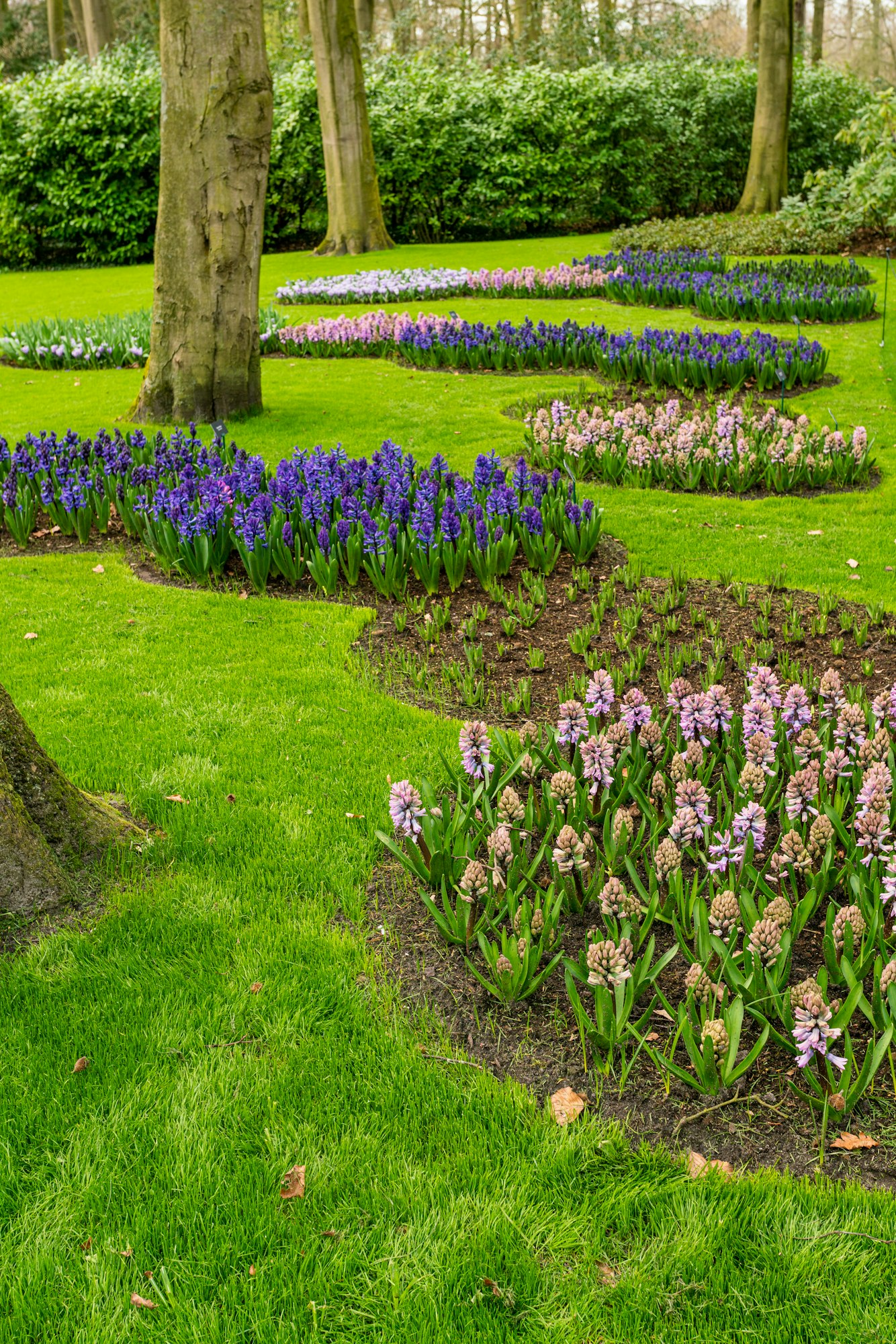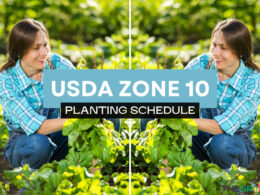In This Article Show
Welcome to our comprehensive guide on the Zone 6 planting schedule, tailored for gardeners looking to optimize their gardens for the year ahead. Understanding your planting zone is crucial for success, and Zone 6, with its unique climate, offers a variety of growing opportunities.
This guide is designed to walk you through each step of the gardening process, from preparing your soil to choosing the right plants for your garden’s specific conditions. Whether you’re planning to grow lush vegetables, vibrant flowers, or hearty perennials, we’ve covered you with expert advice and month-by-month tips to ensure your garden thrives.
Key Factors for Success in Zone 6
Understanding the First and Last Frost Dates
In Zone 6, knowing your frost dates is like having a secret weapon. These dates mark the start and end of your growing season. Typically, the last frost occurs around mid to late April, and the first fall frost hits by late October. These aren’t set in stone but serve as a guide for when it’s safe to plant frost-sensitive plants outdoors. By timing your planting around these frost dates, you can avoid the heartbreak of losing plants to unexpected cold snaps and make the most of the growing season.
Soil Preparation Tips for Zone 6
Soil is the foundation of your garden. In Zone 6, soil preparation starts with testing pH and nutrient levels. Most plants thrive in slightly acidic soil to neutral (pH 6.0-7.0). You might need to amend your soil based on your soil test results. Adding organic matter, such as compost or well-rotted manure, can improve soil structure, nutrient content, and water retention. Consider also adding mulch to conserve moisture and suppress weeds. Remember, well-prepared soil is key to healthy, productive plants.
Importance of Selecting the Right Plant Varieties
Not all plants are suited for Zone 6’s climate, so selecting the right varieties is crucial for gardening success. Look for plants labeled as hardy in USDA Zones 6 or lower. These plants are adapted to withstand the typical winter temperatures of our zone. When choosing vegetables and annuals, consider the length of the growing season and select varieties that will mature within that timeframe. Also, diversify your garden with native plants, which are well-adapted to the local climate and beneficial for supporting local wildlife.

Zone 6 Planting Schedule: Month-by-Month Guide
Early Spring (February – April)
Vegetables and Herbs to Start Indoors
Early spring is the perfect time to get a jumpstart on the growing season in Zone 6. Starting seeds indoors allows you to extend the growing season for many vegetables and herbs. In February and March, begin sowing seeds for tomatoes, peppers, eggplants, and herbs like basil and parsley.
Get Gardening For Beginners
Our new EBOOK shows newcomers and green thumbs alike a step by step guide to growing the garden of their dreams.
These plants need a longer growing season and benefit from being started indoors under controlled conditions. Use grow lights and heat mats to mimic the warmth and sunlight they’d receive outside. This early start ensures they’ll be strong and ready for transplanting once the danger of frost has passed.
Preparing the Garden Soil as Soon as It’s Workable
As the snow melts and the soil begins to dry out, it’s time to prepare your garden beds. In Zone 6, this can typically start in March or early April, depending on the weather. Begin by removing any weeds and debris from your garden beds. Then, loosen the soil with a fork or tiller, and enrich it by mixing in ample amounts of compost or aged manure.
This will improve soil fertility and structure, ensuring your plants have the nutrients they need to grow. Testing your soil’s pH and nutrient levels can also guide you in making any necessary adjustments before planting.
Late Spring (May)
Transitioning Indoor Starts to Outdoor
By May, the risk of frost in Zone 6 generally subsides, making it safe to begin transitioning your indoor starts outdoors. This process, known as hardening off, gradually acclimates your plants to outdoor conditions. Start by placing your plants outside in a shaded, protected area for a few hours each day, gradually increasing their exposure to sunlight and outdoor temperatures over a week. This careful transition reduces shock and improves their chances of thriving in their new environment.
Direct Sowing Seeds that Can Handle Spring Temperatures
May is also the ideal time to directly sow seeds that prefer or tolerate cooler soil and air temperatures. Vegetables like carrots, beets, lettuce, and peas can be sown directly into prepared garden beds. These crops do well in the cooler days of late spring and can be harvested in early summer. Additionally, consider planting successions of these vegetables every two weeks to extend your harvest period.
Summer (June – August)
Mid-Summer Planting for Fall Harvest
As summer progresses, Zone 6 gardeners have the opportunity to plan for a fall harvest. Crops like carrots, beets, Swiss chard, and kale planted in June and July can yield a bountiful harvest in the cooler months of fall. Additionally, planting a second round of fast-maturing crops such as lettuce, spinach, and radishes in late summer ensures a continuous supply of fresh vegetables. These late plantings benefit from the remaining warmth of summer while maturing in the cooler temperatures that many of these crops prefer.
Maintaining Moisture and Mulching
Consistent moisture and effective mulching are key to thriving summer gardens. Regular watering becomes crucial as the temperatures rise, and soaker hoses or drip irrigation can provide plants with deep, consistent moisture. Mulching around your plants with organic materials like straw, grass clippings, or shredded leaves helps retain soil moisture, suppress weeds, and stabilize soil temperatures. A layer of mulch can make a significant difference in the health and productivity of your summer garden.
Get Gardening For Beginners
Our new EBOOK shows newcomers and green thumbs alike a step by step guide to growing the garden of their dreams.
Fall (September – October)
Planting Perennials and Bulbs for Spring Bloom
Fall is the ideal time for Zone 6 gardeners to plant perennials and bulbs that will brighten up the garden in spring. Planting bulbs such as tulips, daffodils, and alliums in the cooler fall months allows them to establish roots and undergo the necessary cold dormancy period before spring. Similarly, planting perennials like hostas, daylilies, and peonies in the fall gives them a head start to establish themselves and bloom beautifully in the spring and summer months to come.
Preparing the Garden for Winter
As the growing season winds down, preparing your garden for winter is crucial for its next year’s success. Remove spent plants and debris to reduce the risk of pests and diseases overwintering in your garden. Consider planting cover crops such as clover or winter rye in empty beds to protect and enrich the soil. Additionally, fall is the perfect time to add amendments like compost or manure to your garden beds, as these will have time to break down over winter, enriching the soil for spring planting. Protecting perennials with mulch can also help insulate them against harsh winter temperatures.
By carefully planning and maintaining your garden through the summer and into fall, you can extend your growing season, ensure the health of your garden through the winter, and set the stage for a successful spring.
Vegetable Planting Guide For Zone 6

Creating a vegetable planting guide tailored for Zone 6 involves understanding the local climate, including frost dates and the length of the growing season. Below is a simplified chart highlighting common vegetables and their optimal planting times, along with some tips for success with each vegetable to help ensure a bountiful harvest.
Zone 6 Vegetable Planting Guide
| Vegetable | Indoor Start | Direct Sow Outdoor | Tips for Success |
|---|---|---|---|
| Tomatoes | Feb – Mar | After last frost (May) | Start indoors 6-8 weeks before last frost. Harden off before transplanting. Choose varieties suited for Zone 6. Support with cages or stakes. |
| Peppers | Feb – Mar | After last frost (May) | Start indoors 8-10 weeks before last frost. Requires warm soil; consider using black plastic to warm soil before transplanting. |
| Lettuce | Mar | Mar – Apr; Aug – Sep | Can be started indoors or directly sown. For a continuous harvest, sow seeds every 2 weeks. Prefers cooler temperatures. |
| Carrots | N/A | Apr – May; Aug | Direct sow in well-drained soil. Thin seedlings to prevent crowding. Keep soil moist for best growth. |
| Beets | N/A | Apr – May; Jul – Aug | Direct sow in rich, loose soil. Space adequately and provide consistent moisture for even growth. |
| Kale | Mar | Mar – Apr; Jul – Aug | Can start indoors or sow directly. Kale appreciates cooler weather and can become sweeter after a frost. |
| Spinach | Mar | Mar – Apr; Aug – Sep | Direct sow in fertile soil. Prefers cool weather; summer heat can cause bolting. |
| Squash | Apr | After last frost (May) | Start indoors 3-4 weeks before last frost or sow directly after last frost. Provide ample space for sprawling. |
| Cucumbers | Apr | After last frost (May) | Start indoors or sow directly. Use trellises to save space and encourage straighter cucumbers. |
| Radishes | N/A | Mar – Apr; Aug – Sep | Direct sow and enjoy fast growth. Avoid overcrowding for optimal size. Can tolerate partial shade. |
Tips for Success with Each Vegetable
- Tomatoes and Peppers: Warmth lovers; ensure soil is warm and danger of frost has passed before transplanting outdoors. Mulching helps retain soil moisture and warmth.
- Lettuce, Spinach, and Kale: Thrive in cooler temperatures. Use shade cloth to extend growing season into warmer months.
- Root Vegetables (Carrots, Beets, Radishes): Prepare beds with deep, loose soil free of stones. Consistent moisture is key to smooth growth.
- Squash and Cucumbers: Provide plenty of space for growth or use vertical gardening techniques. Watch for pests like squash bugs and cucumber beetles.
- All Vegetables: Rotate crops each year to prevent disease and nutrient depletion. Use organic mulch to suppress weeds, retain moisture, and regulate soil temperature.
By following these guidelines and adjusting based on your garden’s specific conditions, you can maximize your vegetable harvest in Zone 6. Remember, the key to successful gardening is observation and adaptation, so keep notes on what works best in your garden to refine your approach each year.
Zone 6 Flower Planting Guide

Annuals for Zone 6
Annuals complete their life cycle in one year, offering quick, vibrant color throughout the growing season.
- Marigolds: Plant after the last frost. They love full sun and well-draining soil. Great for borders and pest control.
- Petunias: Start indoors 6-8 weeks before the last frost or plant outdoors after the danger of frost has passed. Thrive in full to partial sun.
- Zinnias: Direct sow after the last frost. Easy to grow and excellent for cut flowers. Full sun and well-draining soil will produce vibrant blooms.
- Impatiens: Plant in shaded areas after the last frost. Keep soil moist for continuous blooms.
- Cosmos: Direct sow after the last frost. They are drought-tolerant and thrive in poor soil with full sun.
Perennials for Zone 6
Perennials return year after year, forming the backbone of the garden landscape.
- Daylilies: Plant in spring or fall. They prefer full sun to partial shade and adapt to a variety of soil conditions.
- Hostas: Best planted in spring or fall. Thrive in shade; great for foliage interest under trees or in shadowed garden corners.
- Coneflowers (Echinacea): Plant in spring or fall. Drought-tolerant and thrives in full sun. Attracts pollinators.
- Peonies: Plant bare-root peonies in the fall for blooms in late spring. Require well-drained soil and full to partial sun.
- Black-eyed Susans (Rudbeckia): Plant in spring or fall. They love full sun and tolerate poor soil, drought, and heat.
Planting Tips for Floral Success and Color Year-Round
- Soil Preparation: Most flowers perform best in well-draining soil enriched with compost. Test your soil and amend as necessary.
- Sunlight: Understand the light requirements of each plant. Full sun typically means at least 6 hours of direct sunlight, while partial shade refers to filtered or indirect light.
- Watering: Establish a consistent watering routine, especially for annuals. Perennials may be more drought-tolerant once established.
- Mulching: Apply a layer of organic mulch around your plants to retain moisture, regulate soil temperature, and reduce weed growth.
- Deadheading: Regularly remove spent blooms, especially for annuals, to encourage more flowers.
- Seasonal Interest: Plan your garden so plants bloom in spring, summer, and fall. Consider foliage color and texture for year-round interest.
- Spacing: Pay attention to spacing recommendations when planting. Overcrowded plants compete for resources and are more prone to disease.
By choosing the right plants for your Zone 6 garden and following these tips, you can enjoy a beautiful, colorful garden that blooms from spring through fall.
Herbs and Fruit Trees for Zone 6

Gardening in Zone 6 offers a wide range of possibilities for growing both herbs and fruit trees. The moderate climate allows for a diverse selection of plants that can thrive and produce bountiful harvests.
Best Herbs to Grow in Zone 6
Herbs are generally easy to care for and can be grown in the ground or containers, making them versatile for gardeners with varying amounts of space.
- Basil: Loves warm weather and full sun. Plant after the last frost, and keep the soil moist. Pinch off flower heads to encourage leaf growth.
- Mint: Thrives in both sun and partial shade. Be cautious as it can become invasive; consider planting in containers to control its spread.
- Rosemary: Prefers full sun and well-draining soil. It’s perennial in Zone 6 but can be brought indoors in extremely cold winters.
- Thyme: Grows well in full sun and requires well-draining soil. It’s drought-tolerant once established, making it low maintenance.
- Parsley: Can handle partial shade. Keep the soil consistently moist for best growth. It’s biennial, often grown as an annual.
Recommended Fruit Trees and Berry Bushes for Zone
Fruit Trees and berry bushes in Zone 6 can produce delicious crops with the right care and selection.
- Apple Trees: Choose cold-hardy varieties suited to Zone 6, such as ‘Honeycrisp’ and ‘Fuji’. Plant in full sun and well-draining soil.
- Pear Trees: Varieties like ‘Bartlett’ and ‘D’Anjou’ do well. They need full sun and well-drained soil. Ensure cross-pollination by planting at least two varieties.
- Peach Trees: Select cold-hardy varieties such as ‘Reliance’ or ‘Redhaven’. Full sun and good air circulation are crucial to prevent fungal diseases.
- Cherry Trees: Both sweet (like ‘Bing’ and ‘Stella’) and sour (like ‘Montmorency’) cherries can be grown. They need full sun and well-drained soil.
- Blueberry Bushes: Require acidic soil (pH 4.5 to 5.5). Plant in full sun and mulch with pine needles or peat moss to maintain soil acidity.
- Raspberry and Blackberry Bushes: Need full sun and well-draining soil. Support with trellises or wires, and prune annually for best production.
Care Tips for Herbs and Fruit Trees in Zone 6
- Soil and Sunlight: Ensure your plants are in the appropriate type of soil and sunlight for their needs. This is crucial for their health and productivity.
- Watering: Fruit trees and bushes require consistent moisture, especially during fruit development. Herbs generally prefer well-draining soil and should not be overwatered.
- Pruning: Regular pruning of fruit trees and berry bushes is essential for encouraging healthy growth and fruit production. Herbs should be harvested regularly to encourage new growth.
- Mulching: Apply mulch around the base of plants to retain moisture, regulate soil temperature, and suppress weeds.
- Pest and Disease Management: Monitor for signs of pests and diseases. Use organic methods whenever possible to address any issues promptly.
- With the right care and selection based on Zone 6’s climate, you can enjoy various herbs and fresh fruit from your garden. Whether you’re a seasoned gardener or just starting, incorporating these plants into your garden can bring great joy and bountiful harvests.
Lawn and Landscape Plants for Zone 6

Zone 6 offers a favorable climate for a diverse range of lawn grasses, shrubs, and trees, allowing homeowners to create beautiful and resilient landscapes. Here’s a guide to selecting the right types for your Zone 6 garden.
Grass Types Suitable for Zone 6
The climate in Zone 6 is characterized by cold winters and warm summers, making it suitable for both cool-season and some warm-season grasses, depending on the specific area and microclimate.
Cool-Season Grasses
These grasses thrive in the cooler temperatures of spring and fall and tend to struggle in the hot summer months without adequate water.
- Kentucky Bluegrass: Known for its fine texture and rich color, it requires full sun to partial shade and moderate maintenance.
- Tall Fescue: Tolerates heat and drought better than other cool-season grasses. It’s suitable for a variety of soils and prefers full sun to partial shade.
- Perennial Ryegrass: Quickly germinating and establishing, it offers a fine texture and requires full sun to light shade. It’s often mixed with other grass types to enhance a lawn’s durability and appearance.
Warm-Season Grasses
These can be suitable for the warmer parts of Zone 6, especially in areas transitioning to Zone 7.
- Zoysia Grass: Offers excellent heat and drought tolerance once established. It has a fine texture and dense growth, requiring full sun to partial shade.
Shrubs and Trees That Thrive in Zone 6
Shrubs and trees are essential for creating structure and year-round interest in your landscape.
Shrubs
- Hydrangeas: With varieties like ‘Annabelle’ or ‘Endless Summer’, hydrangeas offer large, beautiful blooms in summer. They prefer partial shade and moist, well-drained soil.
- Boxwood: Ideal for hedges and borders, boxwoods are evergreen shrubs that can be shaped as desired. They adapt well to various conditions but prefer well-drained soil and partial to full sun.
- Rhododendrons: These evergreen shrubs bloom in the spring and prefer acidic soil, partial sun, and shelter from harsh winds.
Trees
- Maple Trees (Acer spp.): Varieties like the ‘Red Maple’ or ‘Sugar Maple’ are excellent for Zone 6, providing stunning fall color. They prefer full sun to partial shade and well-draining soil.
- Oak Trees: Oaks like the ‘White Oak’ or ‘Red Oak’ are hardy and long-lived, offering beautiful foliage and valuable habitat for wildlife. They require full sun and well-drained soil.
- Dogwood Trees: Known for their spring blooms and attractive fall foliage, dogwoods are a great choice for smaller landscapes. They prefer partial shade and moist, acidic soil.
Care Tips for Lawn and Landscape Plants in Zone 6
- Soil Testing and Amendment: Test your soil to determine pH and nutrient levels before planting. Amend the soil as needed to meet the requirements of your selected plants.
- Watering: Establish a regular watering schedule, especially for newly planted grass, shrubs, and trees. Deep, infrequent watering encourages deep root growth.
- Mulching: Apply mulch around shrubs and trees to retain moisture, regulate soil temperature, and reduce weed competition.
- Pruning: Prune shrubs and trees to maintain their shape and health. It’s best to prune most flowering shrubs immediately after they bloom not to cut off next year’s buds.
- Fertilization: Apply fertilizer based on the specific needs of your plants and lawn. Slow-release fertilizers can provide a steady supply of nutrients over time.
Monthly Maintenance Tips for Zone 6 Gardens

January
- Plan and Order Seeds: Start planning your garden layout and order seeds for the upcoming season.
- Tool Maintenance: Clean, sharpen, and repair garden tools.
February
- Start Seeds Indoors: Begin starting seeds indoors for vegetables and flowers that require a longer growing season.
- Prune Trees and Shrubs: Late winter is a good time to prune dormant trees and shrubs, except for those that bloom in spring.
March
- Prepare Garden Beds: As the soil becomes workable, clean up beds, remove debris, and amend soil with compost.
- Start Early Crops Outdoors: Plant cool-season vegetables and hardy annuals.
April
- Transplant Seedlings: Begin hardening off and transplanting seedlings after the last frost date.
- Mulch Beds: Apply mulch to garden beds to suppress weeds and retain moisture.
May
- Plant Warm-Season Crops: It’s safe to plant warm-season vegetables, annuals, and perennials.
- Pest and Disease Monitoring: Begin regular inspections for pests and diseases.
June
- Watering: Establish a regular watering schedule, especially for new plantings.
- Deadheading: Remove spent blooms from flowers to encourage new growth.
July
- Harvest Vegetables: Regularly harvest vegetables to encourage continued production.
- Weed Control: Keep on top of weeding to prevent competition for nutrients and water.
August
- Start Fall Crops: Plant seeds for fall-harvested vegetables.
- Prune Perennials: Deadhead and prune perennials as necessary to maintain appearance and health.
September
- Lawn Care: Overseed and fertilize the lawn as needed.
- Plant Bulbs: Plant spring-flowering bulbs.
October
- Prepare for Winter: Begin winterizing the garden by removing spent annuals and mulching perennials.
- Plant Trees and Shrubs: Fall is a great time for planting as it allows roots to establish.
November
- Cleanup: Clean up leaves and debris to reduce overwintering pests and diseases.
- Protect Sensitive Plants: Wrap or mulch sensitive plants to protect them from winter weather.
December
- Plan for Next Year: Review notes from the past season and start planning for next year.
- Rest and Reflect: Give yourself a break and enjoy the downtime before the cycle begins again.
Importance of Pest Control and Disease Management
- Regular Monitoring: Early detection is crucial for managing pests and diseases. Regularly inspect your plants for signs of trouble.
- Cultural Practices: Use cultural practices like crop rotation, proper spacing for air circulation, and choosing disease-resistant varieties to minimize issues.
- Natural Solutions: Whenever possible, use natural solutions like beneficial insects, barriers, and organic sprays to manage pests and diseases.
- Chemical Controls: Use chemical controls as a last resort and follow label instructions carefully to minimize harm to beneficial organisms and the environment.
Following this monthly maintenance checklist and implementing effective pest control and disease management strategies, you can maintain a healthy, vibrant garden throughout the year.










